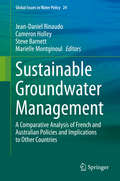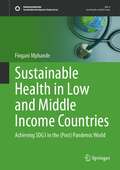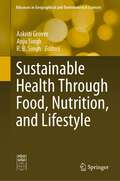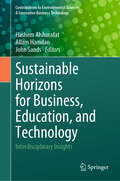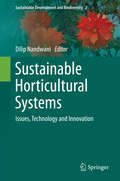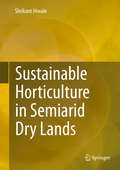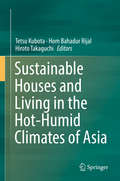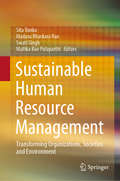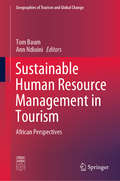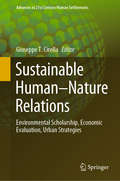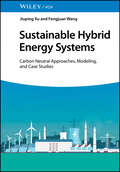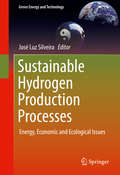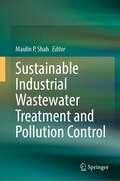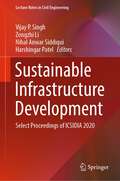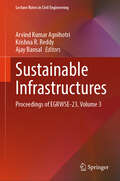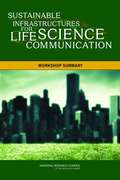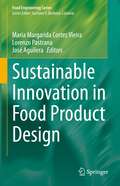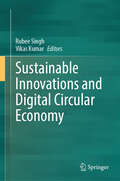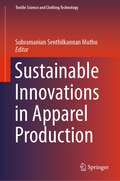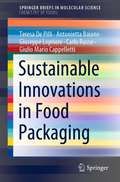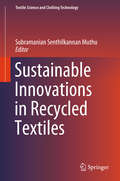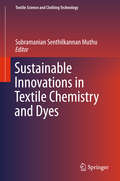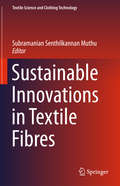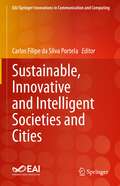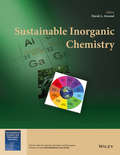- Table View
- List View
Sustainable Groundwater Management: A Comparative Analysis of French and Australian Policies and Implications to Other Countries (Global Issues in Water Policy #24)
by Steve Barnett Jean-Daniel Rinaudo Cameron Holley Marielle MontginoulThis book describes and analyses the diversity of possible approaches and policy pathways to implement sustainable groundwater development, based on a comparative analysis of numerous quantitative management case studies from France and Australia.This unique book brings together water professionals and academics involved for several decades in groundwater policy making, planning or operational management to reflect on their experience with developing and implementing groundwater management policy. The data and analysis presented accordingly makes a significant contribution to the empirical water management literature by providing novel, real world insights unpublished elsewhere. The originality of the contributions also lies in the different disciplinary perspectives (hydrogeology, economics, planning and social sciences in particular) adopted in many chapters. The book offers a unique comparative analysis of France, Australia and experiences in countries such as Chile and the US to identify similarities, but also fundamental differences, which are analysed and presented as alternative policy options – these differences being mainly related to the role of the state, the community and market mechanisms in groundwater management.
Sustainable Health in Low and Middle Income Countries: Achieving SDG3 in the (Post) Pandemic World (Sustainable Development Goals Series)
by Fingani MphandeThis book highlights lessons from the COVID-19 pandemic and explains how these can be used to build sustainable health systems, especially in Low- and Middle-Income Countries (LMIC). It investigates the impact of outbreak response and management on health sustainability in LMIC from the perspective of SDG3: “Ensuring healthy lives and wellbeing for all at all ages”. Despite strides being made in some areas for SDG target 3.3 to fight communicable diseases, the COVID-19 pandemic has caused interruptions that will considerably affect vaccination coverage as well as the progress that was made, for example: in reducing malaria cases. Vulnerable populations who were already struggling to access their healthcare needs before the pandemic may face even greater challenges at present and in the years to come, post-pandemic. This book considers the progress on attaining the SDG3 targets, specifically: to improve early warning systems for management of national and global health risks, and the effect of pandemics - including but not limited to the COVID-19 pandemic - and emerging disease outbreaks. It explores the weaknesses and strengths in LMIC and how to strengthen capacities in these countries. The author also investigates and proposes approaches that can, or should, be implemented to ensure sustainable health systems in developing countries, including early warning systems, risk reduction, and the management of global and national health risks. This book is of great interest to public health professionals, infectious diseases experts, and epidemiologists, as well as students and researchers of public health systems and healthcare infrastructure in developing countries.
Sustainable Health Through Food, Nutrition, and Lifestyle (Advances in Geographical and Environmental Sciences)
by Aakriti Grover Anju Singh R. B. SinghThis book uncovers the multiple layers of challenges posed to achieve sustainable human health and improves the understanding of interactive areas set by the UN Sustainable Development Goals (1) no poverty, (2) zero hunger, (3) good health and wellbeing, (6) clean water and sanitation, and (11) sustainable cities and communities. The book focuses on conceptual understanding, food, nutrition, lifestyle, and their integration to reinforce the ideas of holistic health principles.' The most important drivers of sustainable health are food, nutrition, and lifestyle. Healthy food is a basic need of human beings. In under-developed regions, people are underweight and facing malnutrition, with a prevalence of deficiency diseases due to low intake of micro-nutrients such as vitamin A, iodine, and protein among others. A good diet as well as lifestyle has a tremendous bearing on a person’s health, emotional stability, and enthusiasm for life. The global coronavirus pandemic has brought unimaginable devastation and hardship in all corners of the globe, questioning the existing healthcare services, health policies, and health planning across the developed and developing countries. It has also exposed the lacunae in understanding health, the base of human happiness. The global community needs to gravely ponder the health issues we are facing and explore sustainable solutions for health recovery and the wellbeing of humanity.
Sustainable Horizons for Business, Education, and Technology: Interdisciplinary Insights (Contributions to Environmental Sciences & Innovative Business Technology)
by Allam Hamdan Hashem Alshurafat John SandsThis book offers a detailed analysis of the intersection of sustainability, innovation, and global progress, and it comprehensively explores sustainable practices and their impact on business, education, and technology. The book shows how businesses can incorporate sustainability into their core operations, including environment-friendly supply chains, renewable energy adoption, circular economy models, ethical decision-making, and sustainable growth strategies. Successful sustainable businesses and the benefits of their socially responsible practices are highlighted. In addition, the book explores how education can shape a sustainable future. It is necessary to integrate the ideas of sustainability into the curricula of early childhood education to higher learning institutions to educate and empower the next generation of changemakers. The role of technology in advancing sustainability efforts is also investigated, including artificial intelligence, blockchain, clean energy solutions, green architecture, and smart cities. Other topics explored in the book include global sustainability efforts such as international collaborations, public-private partnerships, and multilateral initiatives; the role of governments, NGOs, and international organizations in promoting sustainable development; ethical considerations and social impacts of sustainable practices, for example, social justice, inclusivity, and environmental stewardship; connections between sustainable development and improved quality of life; and groundbreaking ideas and innovations for industries to tackle sustainability issues. The book offers a comprehensive and forward-looking perspective on sustainability. By combining different viewpoints, the book empowers readers with the knowledge and inspiration to contribute meaningfully to a more sustainable, inclusive, and resilient world.
Sustainable Horticultural Systems
by Dilip NandwaniSustainable horticulture is gaining increasing attention in the field of agriculture as demand for the food production rises to the world community. Sustainable horticultural systems are based on ecological principles to farm, optimizes pest and disease management approaches through environmentally friendly and renewable strategies in production agriculture. It is a discipline that addresses current issues such as food security, water pollution, soil health, pest control, and biodiversity depletion. Novel, environmentally-friendly solutions are proposed based on integrated knowledge from sciences as diverse as agronomy, soil science, entomology, ecology, chemistry and food sciences. Sustainable horticulture interprets methods and processes in the farming system to the global level. For that, horticulturists use the system approach that involves studying components and interactions of a whole system to address scientific, economic and social issues. In that respect, sustainable horticulture is not a classical, narrow science. Instead of solving problems using the classical painkiller approach that treats only negative impacts, sustainable horticulture treats problem sources.
Sustainable Horticulture in Semiarid Dry Lands
by Shrikant HiwaleThis book discusses ways of increasing production/unit area by making full use of the soil and water under the harsh climatic conditions of semiarid areas. This leads to improved sustainability, increased availability of fresh produce, which is vital for human health and higher incomes for small and marginal farmers. Arid and semiarid areas account for almost 70 per cent of the total cropped area of India. In these areas physical constraints like low and erratic rainfall, high temperature, high wind velocity, low fertility, poor soil structure, salinity of soil and ground water all limit reliable crop production. In the absence of any type of aggregation, the soils are highly erodible, lack structure and have a very coarse in texture with low water holding capacity. Intensive agricultural practices, increasing population pressure, climatic changes, environmental pollution, loss of biodiversity, soil erosion, salinization and water depletion are all threatening the sustainability of agriculture. In view of the mounting demand for food, it is vital to link enhanced food production with nutritional security, conservation of natural resources, increasing farmers' incomes, employment generation through agricultural diversification. Horticulture, particularly of fruit trees, can play a major role in solving the problem of nutrition, as fruits are rich source of vitamins and minerals and have antioxidant properties. Fruit trees, which are mostly deciduous, add leaf litter to the soil, and this ultimately helps to improve the condition of the soil. In addition, fruit trees are known to reduce soil erosion and reduce run off. The trees also play a major role in purifying the environment as they are the known carbon sequesters. Fruit-tree cultivation is a profitable preposition. There is no scope to increase the land surface; all increase in productivity therefore has to be from the available land. This means introducing cropping systems that can meet the basic food, fodder and fuel requirement of farming families.
Sustainable Houses and Living in the Hot-Humid Climates of Asia
by Tetsu Kubota Hom Bahadur Rijal Hiroto TakaguchiThis book provides information on the latest research findings that are useful in the context of designing sustainable houses and living in rapidly growing Asian cities. The book is composed of seven parts, comprising a total of 50 chapters written by 53 authors from various countries, mainly in the Asian region. Part I introduces vernacular houses in different Asian countries such as Indonesia, Malaysia, India, Nepal, China, Thailand and Laos. Parts II and III then explore in depth indoor adaptive thermal comfort and occupants’ adaptive behavior, focusing especially on those in hot-humid climates. Part IV presents detailed survey results on household energy consumption in various tropical Asian cities, while Part V analyses the indoor thermal conditions in both traditional houses and modern houses in these countries. Several real-world sustainable housing practices in Asian cities are reviewed in the following part. The final part then discusses the vulnerability of expanding Asian cities to climate change and urban heat island. Today, approximately 35-40% of global energy is consumed in Asia, and this percentage is expected to rise further. Energy consumption has increased, particularly in the residential sector, in line with the rapid rise of the middle class. The majority of growing Asian cities are located in hot and humid climate regions, and as such there is an urgent need for designers to provide healthy and comfortable indoor environments that do not consume non-renewable energy or resources excessively. This book is essential reading for anyone with an interest in sustainable house design in the growing cities of Asia.
Sustainable Human Resource Management: Transforming Organizations, Societies and Environment
by Sita Vanka Madasu Bhaskara Rao Swati Singh Mallika Rao PulaparthiThis book provides a multi-stakeholder perspective on sustainable HRM for the policymakers, managers and academics, addressing issues, approaches, research studies/frameworks and emerging patterns relating to the subject. It discusses various aspects of sustainability, such as making HR more responsible for ensuring sustainability focusing on the triple bottom line, characteristics of sustainable HRM, psychological contracts, emotional intelligence, and psychological capital. The book also explores organizational citizenship behavior, employment relations, employee engagement, sustainable leadership, disruptive HR practices, sustaining employee motivation, educational sustainability, sustainable career management, sustainable environment, employer and employee branding, sustainable organizations, organization culture, training for sustainability, sustainable employee performance, business sustainability and sustainable employability. It provides an update on the concept, processes, issues and emerging paradigms from multidimensional and cross-country perspectives to showcase sustainable HR practices, and appeals to the academics, practitioners and policymakers in the area of HRM.
Sustainable Human Resource Management in Tourism: African Perspectives (Geographies of Tourism and Global Change)
by Tom Baum Ann NdiuiniThis book addresses the application of sustainable HRM principles within tourism in the specific context of Africa, a neglected area of study. It draws on diverse aspects of HRM, from the micro- (individual) through the meso-level (organisational) to the macro-level (policy, governmental). It also reflects the diverse challenges facing a critical area within emerging African tourism, that of its workforce. The book is substantially research-based and provides a state-of-the-art picture of emergent studies in this area, drawing on case examples from a wide-range of African contexts. As such, it provides a comprehensive resource and starts discussion in an emergent research area.
Sustainable Human–Nature Relations: Environmental Scholarship, Economic Evaluation, Urban Strategies (Advances in 21st Century Human Settlements)
by Giuseppe T. CirellaThis book addresses sustainability thinking and the bigger picture, by taking into consideration how and from where contemporary schools of thought emerged approximately a quarter-century ago. Evidence from the literature illustrates a number of key concepts and techniques that have been tested and continue to be tested, within various multi-disciplinary fields, on societal functionality. Research into sustainable societies needs to be sound, ethical, and creative. A cross-sectoral, interdisciplinary examination of challenges and strategies is used to interlink sustainability thinking and human-nature relations. With an ever-growing number of people now concentrated within urban areas, providing not only environmental quality and livable space, but also security and resilient urban systems, is becoming increasingly important. This urbanization trend has overlapped with environmental degradation, consumption of natural resources, habitat loss, and overall ecosystem change. Consequently, the goal is for cleaner, safer societies – with higher standards of living – to excel in support of current and future generational communities. The book tackles these challenges by integrating environmental scholarship, economic evaluation, and urban strategies under one umbrella of thought. The relational paradigms presented include examples that correlate developed and developing countries, socioeconomics and community development, and governance of knowledge and education. As such, the book argues, furthering of knowhow should be accessible and shared in order to achieve maximum innovation and benefit. Sustainability thinking, after all, is a metric for intrinsic human-nature relations in terms of past performance, present development, and future goals. This book discusses this metric and offers novel approaches to growing societies and what we can do next.
Sustainable Hybrid Energy Systems: Carbon Neutral Approaches, Modeling, and Case Studies
by Jiuping Xu Fengjuan WangSustainable Hybrid Energy Systems Discovering comprehensive approaches to build sustainable hybrid energy systems Hybridization is the eternal theme of human energy utilization. However, it has never been more important than it is now because of the urgency of promoting energy transition and achieving carbon neutrality. Therefore, exploring the design, combustion, operation, and policy challenges of sustainable hybrid energy systems becomes increasingly important. Sustainable Hybrid Energy Systems: Carbon Neutral Approaches, Modeling, and Case Studies provides a detailed explanation of these aspects. Dividing hybrid energy systems into three categories—co-located, co-combusted, and co-operated, this book emphasizes the deployment optimization, emission quota allocation, scheduling coordination, and renewable portfolio standards implementation of these systems. The results are essential tools for understanding the current and future of multi-input single-output hybrid energy systems. Sustainable Hybrid Energy Systems readers will also find: Clear logical framework that reveals the constitutes of hybrid energy systems.Systematic technical scheme for building an economic, environmental, flexible, and resilient future energy system.Extensive case studies from single power plant level, multiple power plant level, and grid level.Effective guidelines for wider application of the proposed carbon neutral approaches. Sustainable Hybrid Energy Systems is ideal for power engineers, electrical engineers, scientists in industry, and environmental researchers looking to understand these energy solutions. It will also provide collectible value for libraries.
Sustainable Hydrogen Production Processes
by José Luz SilveiraThis work presents a comprehensive investigation of the most significant renewable hydrogen production processes. Technical, economic and ecological studies are described for the processes of steam reforming of ethanol, natural gas and biogas; water electrolysis with energy from renewable sources (wind power, photovoltaic and hydroelectric), and hydrogen production using algae. Aimed at mechanical and chemical engineering graduate students and researchers involved in environmental sciences, sustainable energy and bioenergy research, this book introduces readers to the latest developments in the field and provides essential reference material for future research. The book first presents a comprehensive literature review of the processes studied. Subsequently, it provides a technical report on assessing the energetic efficiency for each hydrogen production process, as well as an economic study of the respective hydrogen production costs. Lastly, the ecological efficiency of each process is addressed. Over the past few decades, the UNESP's Group of Optimization of Energetic Systems, headed by Professor Jos#65533; Luz Silveira, has been pursuing research in the field of renewable energy generation. A major part of the group's research focuses on the production of hydrogen as a fuel and its important contribution to mitigating the environmental impacts caused by pollutant emissions.
Sustainable Industrial Wastewater Treatment and Pollution Control
by Maulin P. ShahThis book summarizes the advanced sustainable trends in removing toxic pollutants by environmental and biotechnological processes from both industrial wastewater and sewage wastewater. The book also provides an assessment of the potential application of several existing wastewater bioremediation techniques and introduces new cutting-edge technologies. Among other valuable information covered, here are the methods, procedures, materials (especially low-cost materials originating from industrial and agricultural waste), management of wastewater containing toxic pollutants, and valorization possibilities of waste resulting from the removal of toxic pollutants from wastewater.Tonnes of hazardous waste pollutants released by industries are a challenge worldwide. With the ever-growing population and shrinking landfill areas, managing the disposal of pollutants is a matter of severe concern. Industrial wastewater treatment, recycling, and reuse are serious issues in today’s context, not just to protect the environment from pollution, but also to conserve water resources so that water stress is reduced.This book is designed for engineers, scientists, and other professionals and serves as a good summary of the current state-of-the-art and innovative research challenges to control pollution for coming generations.
Sustainable Infrastructure Development: Select Proceedings of ICSIDIA 2020 (Lecture Notes in Civil Engineering #199)
by Vijay P. Singh Zongzhi Li Nihal Anwar Siddiqui Harshingar PatelThis book presents the select proceedings of the International Conference on Sustainable Infrastructure Development: Innovations and Advances (SIDIA 2020). The book addresses the issues of optimal resource allocation and utilization, construction cost minimization, budget optimization for infrastructure development in hilly terrain as well as plains, to ensure quality and safety with minimal environmental impact. The topics covered include planning, design and construction of sustainable infrastructure projects, policy and practices to be considered for the comprehensive development which is socially inclusive specifically in developing nations, transportation engineering and management which is performance-based and emerging economical models for partnerships, environment engineering and management for ascertaining the best methods for environmental impacts assessment to capture the true indirect costs of a infrastructure project, geotechnical and water resource engineering using new developments, and utilizing the various technological impacts for ensuring disaster preparedness of any region. This book can prove to be useful for beginners, researchers, and professionals interested in the latest advances and innovations in sustainable infrastructure development.
Sustainable Infrastructures: Proceedings of EGRWSE-23, Volume 3 (Lecture Notes in Civil Engineering #355)
by Arvind Kumar Agnihotri Krishna R. Reddy Ajay BansalThis book contains peer-reviewed and selected papers presented during the International Conference on Environmental Geotechnology, Recycled Waste Materials and Sustainable Engineering (EGRWSE) 2023, held at NIT Jalandhar. It discusses the recent innovations, trends, concerns, practical challenges encountered, and the solutions adopted in waste management and engineering, geotechnical and geoenvironmental engineering, infrastructure engineering and sustainable engineering. This book can serve as a useful resource for researchers, educators, policymakers, and professionals working in the field of civil engineering, chemical engineering, environmental sciences, and public policy.
Sustainable Infrastructures for Life Science Communication
by Elizabeth Stallman BrownAdvances in the life sciences - from the human genome to biotechnology to personalized medicine and sustainable communities - have profound implications for the well-being of society and the natural world. Improved public understanding of such scientific advances has the potential to benefit both individuals and society through enhanced quality of life and environmental protection, improved K-12 and undergraduate science education, greater understanding of human connections to the natural world, and more sustainable policies and regulations. Yet few systems of support exist to help life scientist communicators share their research with a broad range of public audiences, or engage the public in discussions about their work. "Sustainable Infrastructures for Life Science Communication" is the summary of a two-part workshop convened in December 2013 and January 2014 by the National Research Council Roundtable on Public Interfaces of the Life Sciences to identify infrastructure-related barriers that inhibit or prohibit life scientists from communicating about their work and characteristics of infrastructure that facilitate or encourage scientists to engage with public audiences. The workshop featured both formal presentations and panel discussions among participants from academia, industry, journalism, the federal government, and nonprofit organizations. The presentations highlighted the motivations of and challenges to life scientist communicators, theoretical approaches to science communication, examples of different types of infrastructure to support science communication, and the need for building more sustainable science communication infrastructures. This report considers communication infrastructure across a range of life science institutions, including federal agencies, academia, industry, and nonprofit organizations and explores novel approaches to facilitate effective science communication.
Sustainable Innovation in Food Product Design (Food Engineering Series)
by Maria Margarida Cortez Vieira Lorenzo Pastrana José AguileraThis book comes out of the 12th Iberoamerican Congress of Food Engineering, which took place at the University of Algarve in Faro, Portugal in July 2019. It includes the editors' selection of the best research works from oral and poster presentations delivered at the conference. The first section is dedicated to research carried out on SUSTAINABLE ALTERNATIVES TO CHEMICAL ADDITIVES TO EXTEND SHELF LIFE, with special emphasis on animal products. The second section discusses recent research in SUSTAINABLE NEW PRODUCT DEVELOPMENT. The third section delves into the development of PLANT-BASED ALTERNATIVES TO DAIRY AND GLUTEN BASED CEREALS. The fourth section tackles CONSUMER BEHAVIOR regarding food products with new sources of protein (e.g. insects) or new sources of important nutrients (e.g. seaweeds) and the fifth discusses the VALORIZATION OF BY-PRODUCTS IN THE FOOD INDUSTRY (from fruits and wine making). For food engineers, food technologists, and food scientists looking to stay up-to-date in this field of sustainable food engineering, Sustainable Innovation in Food Product Design is the ideal resource.
Sustainable Innovations and Digital Circular Economy
by Rubee Singh Vikas KumarThis book explores how circular economy can be applied globally, and what its reshaping potential could prove for industries, communities, and for our lives in future. It discusses how the concept of a circular economy offers an innovative and transformative approach that not only mitigates the negative impacts of traditional linear models, but also unlocks a vast potential for growth and social progress that is underutilized. In order to achieve the objectives of this book, the design and conceptualization have been based on the advantages, as well as the commitment of digital circular economy to maintain environmental sustainability as per the SDGs. With the goal of inspiring readers and policymakers alike to adopt sustainable practices and drive positive change for their respective industries, this book presents to the readers and policymakers the possibilities of sustainable practices. Additionally, it describes how embracing a digital circular economy can reduce waste, increase resource efficiency, and make the economy more resilient and regenerative. Providing practical examples and policy recommendations along with a strategic roadmap, this book provides useful insights and support in defining a path to a more sustainable future.
Sustainable Innovations in Apparel Production (Textile Science And Clothing Technology Ser.)
by Subramanian Senthilkannan MuthuThere have been a lot of innovations in making the garment or apparel production sector sustainable. This book highlights sustainable innovations in the apparel production sector, which is the final destination in the textile production segment. Measuring sustainability in clothing is one of the inevitable areas to deal with when it comes to sustainable apparel production, which is also highlighted here.
Sustainable Innovations in Food Packaging (SpringerBriefs in Molecular Science)
by Teresa De Pilli Antonietta Baiano Giuseppe Lopriore Carlo Russo Giulio Mario CappellettiThis book explores the latest advances in the sustainable production of packaged foods. Packaging plays an important role in sustainable food production and consumption in industrialized countries, where there is an increasing pressure to reduce the environmental impact of packaged foods. For example, the European Union recommends packaging from renewable sources, with a focus on bio-based materials. Sustainable packaging processes guarantee the reuse of the entire waste material and at the same time avoid the loss of food safety and quality during storage by preventing food-borne diseases and chemical contamination. Furthermore, the dramatic problem of plastic waste accumulation and the conservation of oil and food resources need to be taken into consideration. This book presents eco-friendly packaging strategies to reduce food and plastic waste and address the end-of-life issues of persistent materials. It particularly focuses on the production of biodegradable microbial polymers and the use of by-products and waste from the agricultural and food industries. These strategies promote an innovative and productive waste-based food packaging economy, separating the food packaging industry from fossil reserves and allowing bio-polymers to return to the soil. Lastly, the book covers life-cycle assessment, life-cycle costing, and externality assessment to help readers understand the economical reliability of the innovations presented.
Sustainable Innovations in Recycled Textiles (Textile Science And Clothing Technology Ser.)
by Subramanian Senthilkannan MuthuThis book highlights the environmental and economic benefits of recycling in textiles and fashion; vis-a-vis virgin textiles. Recycling plays an inevitable part when it comes to sustainable innovations in textiles and fashion sector. As basic information pertaining to the benefits, challenges of recycling in textiles are discussed to the sufficient extent in the literature, this book deals with the innovative at the same time, sustainable products made from the recycled textiles.
Sustainable Innovations in Textile Chemistry and Dyes (Textile Science And Clothing Technology Ser.)
by Subramanian Senthilkannan MuthuThis book details two elements of textile chemistry namely- sustainable/eco-friendly dyes and green chemistry. It presents latest topics in sustainable dyeing techniques, low impact dyeing methods, wool dyeing techniques and green chemistry. Certain case studies are also highlighted.
Sustainable Innovations in Textile Fibres (Textile Science And Clothing Technology Ser.)
by Subramanian Senthilkannan MuthuThis book highlights the innovations in textile fibres, that is the starting point of the supply chain. There are numerous innovations made in terms of making the existing fibres sustainable and also to discover new sustainable fibres. This book deals with those innovative sustainable textile fibres in detail. It also presents an overview of various current textile fibres, their issues associated with sustainability and how new, sustainable fibres overcome those issues. Finally it discusses the challenges and implications of these sustainable fibres on technical and economic fronts.
Sustainable, Innovative and Intelligent Societies and Cities (EAI/Springer Innovations in Communication and Computing)
by Carlos Filipe da Silva PortelaThis book combines two main topics applied to cities and societies: innovation and sustainability. The book begins by showing a brief overview of the book's main topics; then, the book addresses four main areas which allow our communities to be more attractive, engaging and fun; analytical, descriptive and predictive; healthy, secure and sustainable; and innovative, connected and monitored. This book represents a union of inputs from researchers and practitioners where each chapter has distinct, valuable and practical contributions that turn it unique. The content ranges from theoretical, like studies or analyses to practical, like industrial solutions or engaging systems. Both branches focus on turning our society more attractive, intelligent, inclusive, sustainable, and ready for the future.
Sustainable Inorganic Chemistry (EIC Books)
by David A. AtwoodThe Earth's natural resources are finite and easily compromised by contamination from industrial chemicals and byproducts from the degradation of consumer products. The growing field of green and sustainable chemistry seeks to address this through the development of products and processes that are environmentally benign while remaining economically viable. Inorganic chemistry plays a critical role in this endeavor in areas such as resource extraction and isolation, renewable energy, catalytic processes, waste minimization and avoidance, and renewable industrial feedstocks. Sustainable Inorganic Chemistry presents a comprehensive overview of the many new developments taking place in this rapidly expanding field, in articles that discuss fundamental concepts alongside cutting-edge developments and applications. The volume includes educational reviews from leading scientists on a broad range of topics including: inorganic resources, sustainable synthetic methods, alternative reaction conditions, heterogeneous catalysis, photocatalysis, sustainable nanomaterials, renewable and clean fuels, water treatment and remediation, waste valorization and life cycle sustainability assessment.The content from this book will be added online to the Encyclopedia of Inorganic and Bioinorganic Chemistry.
